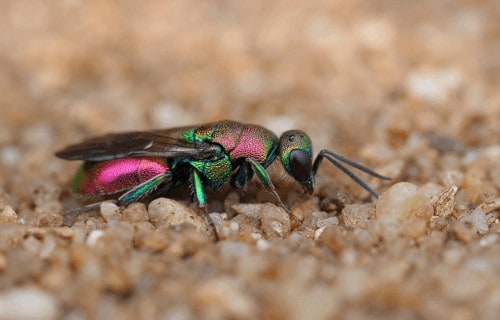
CCL: https://bit.ly/1ryPA8o
We truly hope that you enjoy this article about 7 Wondrous Wasps Worldwide. For those who may be wondering why we would write about wasps, there is a simple reason. Entomologists estimate that roughly 100,000 species of wasp exist on earth today, and perhaps many more. Given that fact, the sheer variety of form and appearance boggles the mind. Obviously, the few do not even scratch the surface where the variety is concerned. But, we hope these 7 Wondrous Wasps Worldwide are enough to whet your appetite for more.
Jewel Wasp
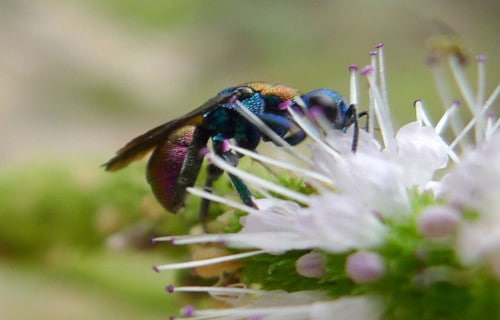
CCL: https://bit.ly/1ryPA8o
Jewel Wasp Facts
- Leading off our list of 7 Wondrous Wasps Worldwide is the mesmerizing beauty known as the Jewel Wasp.
- Firstly, the descriptive term serves as the common name for an extremely unusual species of insect. However, it also goes by another name, even more distinctive. This other name is the Emerald cockroach wasp.
- In addition, this invertebrate represents a rather solitary wasp in the family Ampilicidae. But, unlike many related species, its numbers seem to be stable. Therefore, the IUCN presently has no listing for it.
- Furthermore, this remarkable wasp possesses a unique reproductive behavior, being entomophagous parasites. The female Jewel Wasp actually has a venom with mind-controlling properties.
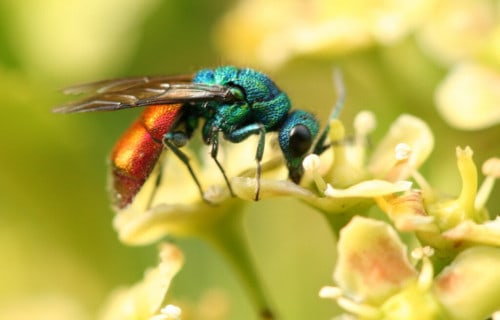
CCL: https://bit.ly/1ryPA8o
Jewel Wasp Physical Description
Most notably, while remarkable in some ways, the Jewel Wasp remains a physically small species. Additionally, this small wasp most commonly displays a slight degree of sexual dimorphism.
As a result, the female of the species generally attains a significantly larger size than the males. She averages roughly 0.85 in (22 mm) in length. Meanwhile, the male commonly grows slightly smaller.
In yet another gender-based difference, the male does not possess a stinger. Yet the female does develop one, however. The reason for this is that the stinger actually plays a role in its reproductive behavior.
- Kingdom: Animalia
- Phylum: Arthropoda
- Class: Insecta
- Order: Hymenoptera
- Family: Ampulicidae
- Genus: Ampulex
- Species: A. compressa
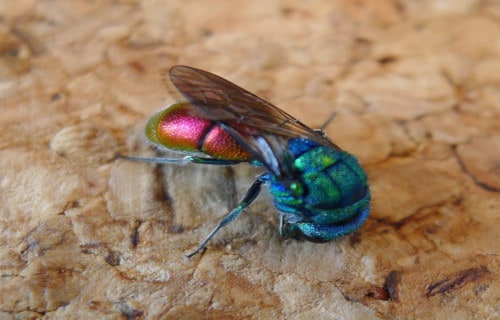
CCL: https://bit.ly/2YAGeT6
Jewel Wasp Distribution, Habitat, and Ecology
First of all, the amazing Jewel Wasp evolved as endemic to a comparatively wide swathe of the world. This range includes Africa, southern and southeastern sections of Asia, and also the Pacific Islands.
Furthermore, the species only thrives in the tropical regions of several areas in its range. In addition, the amazing arthropod also appears in abundant numbers during the warmest portions of the year.
However, its reproductive processes remain the thing for which it is the best known. That’s because of an incredible evolutionary development. To date, its origins remain a complete mystery.
The female stings a victim, which almost always consists of a cockroach. The special venom impairs various motor functions, rendering it helpless. Afterward, the wasp literally leads it around, as if on a leash.
Finally, the wasp leads the victim back to her burrow, where its grisly end awaits. Once there, she lays 1-2 eggs on the immobilized victim. Once the eggs hatch, the larva feed on the cockroach.
Black and Yellow Mud Dauber
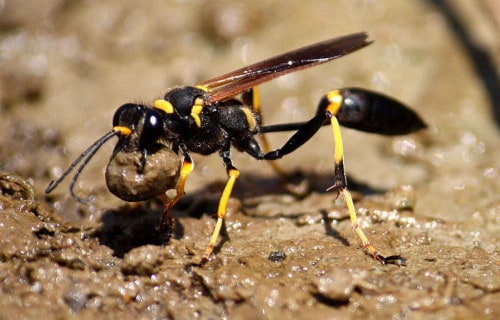
CCL: https://bit.ly/1p2b8Ke
Black and Yellow Mud Dauber Facts
- The colorful Black and Yellow Mud Dauber comes next among our 7 Wondrous Wasps Worldwide. And it truly is a sight to behold
- Most notably, the admittedly somewhat lengthy term aptly serves its purpose. That’s because it serves as the common name for a highly specific species of wasp
- At present, entomologists recognize a total of 30 related species throughout the world. While differences naturally occur, in many ways all of them have many characteristics in common
- The common name derives from the simple fact that it typically constructs its small nest out of the mud. The Black and Yellow Mud Dauber also generally nests in areas that appear to it to be relatively sheltered
- Further, these often include such man-made locations as barns, bridges, and commonly the eaves of many houses. But, as with most known varieties of wasp, this fascinating insect also lives as a highly solitary creature.
- Finally, unlike many species, its numbers appear to be sufficient and stable for the moment. As a result, the IUCN does not have a listing of this particular invertebrate.
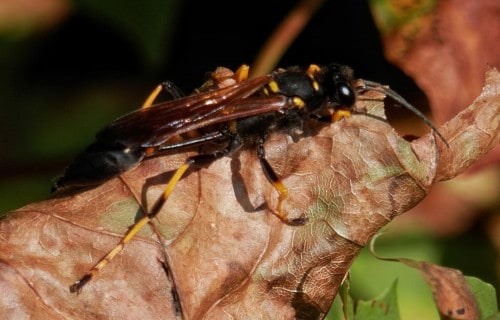
CCL: https://bit.ly/1xMszCg
Black and Yellow Mud Dauber Physical Description
Firstly, the Black and Yellow Mud Dauber possesses an extremely elongated physical form. However, it typically attains a relatively common size, for its kind. As a result, it usually averages a length of roughly 1.2 in (30 mm).
Further, as indicated by the rather descriptive name, its coloring has a very specific pattern. This remains quite distinctive. It therefore appears as a combination of a black body, with bright yellow stripes across it.
In addition, the eyes and antennae also present a deep black in color. Yet, in stark contrast to this, the legs mainly display a brilliant yellow. But, the top, middle, and bottom portions of the legs present black as well.
- Kingdom: Animalia
- Phylum: Arthropoda
- Class: Insecta
- Order: Hymenoptera
- Family: Sphecidae
- Genus: Sceliphron
- Species: S. caementarium
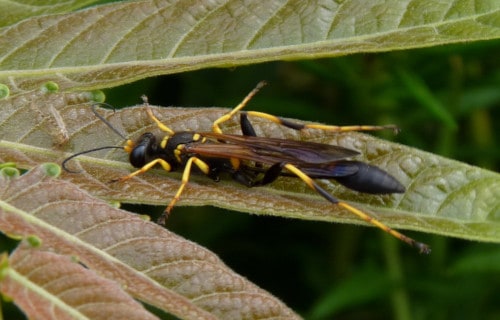
CCL: https://bit.ly/1iowB8m
Black and Yellow Mud Dauber Distribution, Habitat, and Ecology
First of all, the gorgeous Black and Yellow Mud Dauber developed endemically in North America and Central America. However, due to international commerce, it has become established in a many parts of the world.
But, the greater part of its numbers inhabit regions in both Canada and the United States. Nevertheless, within that range the arthropod has preferred habitats. These primarily include rocky ledges, certain trees, and even man-made structures.
While it will obviously defend its nests, the wasp rarely seems overtly aggressive by nature. Stings by this insect happen rarely, and the effects of such occurrences typically stay quite mild.
Further, this species preys exclusively on a moderate variety of spiders. Several species often serve as prey, but Orb weavers remain the most commonly hunted.
These the female returns to the nest, to serve as food for her offspring, once they have hatched into larvae. Finally, the female Black and Yellow Mud Dauber commonly leaves the nest at night, to rest on nearby vegetation.
Cuckoo Wasp

CCL: https://bit.ly/1ryPA8o
Cuckoo Wasp Facts
- You might say that the third of our 7 Wondrous Wasps Worldwide, the amazing Cuckoo Wasp, will drive you crazy for more. Or maybe that’s just us.
- Firstly, the unusual name serves as the common name for any member of a rather extensive group of parasitic wasps. Furthermore, more than 3,000 species exist within this impressive group.
- Additionally, most of the varieties possess brilliantly colored bodies, with metallic sheens. Therefore, individuals sometimes refer to various species by another term. Metallic wasps constitutes the other name.
- Also, the common name of these amazing invertebrates has a rather unique origin. That’s because it derives from the unusual behavior displayed by the females of the genus when laying eggs.
- These the female typically lays within the nests of other species. The other insects, therefore, then act as unwitting hosts. This unusual behavior bears the name of kleptoparasitism.
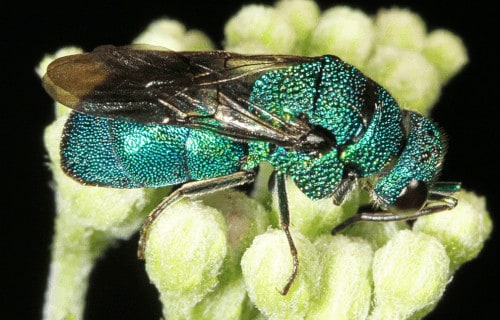
CCL: https://bit.ly/1ryPA8o
Cuckoo Wasp Physical Description
Most notably, the physical appearance of the Cuckoo Wasp varies significantly. This occurs because the term collectively refers to an extensive group of species. However, certain basic physical patterns do exist.
Firstly, the great majority of the members of this group rarely exceed 0.5 in (1.2 cm) in length. The coloring also varies slightly among varieties. But, it most commonly includes metallic shades of green or blue. Yet red or pink appear occasionally.
Also, the abdomen remains quite flexible. This, therefore, allows the creature to curl into a tight ball as a means of defense. The pitted exoskeleton further provides it protection from most attackers.
- Kingdom: Animalia
- Phylum: Arthropoda
- Class: Insecta
- Order: Hymenoptera
- Family: Chrysididae

CCL: https://bit.ly/1ryPA8o
Cuckoo Wasp Distribution, Habitat, and Ecology
First of all, the various types of Cuckoo Wasp also live throughout a large range. As a result, it inhabits nearly all warm regions of the world. Yet, the majority inhabits desert regions. Some varieties, however, do prefer subtropical or Mediterranean climates.
In the state of California alone, in the United States, 166 species of this invertebrate exist. As a result of this fact, this represents the largest concentration of different species of this amazing group in North America.
Further, all known varieties live solitary lives. Also, nearly all feed as external parasites. Prey typically consists of the larvae of larger bees or wasps. Yet a handful of species also visit flowers for additional sustenance.
Asian Giant Hornet
Asian Giant Hornet Facts
- Our next inclusion in this compendium of 7 Wondrous Wasps Worldwide is the unforgettable Asian Giant Hornet.
- Most notably, the term includes the subspecies of Japanese giant hornet. This serves as the common name for the Vespa mandarinia. It also forms the largest known hornet on earth.
- The amazing insect also remains colloquially popular as the yak-killer hornet in some regions. But, people often mistake it for a related species that now represents an invasive species in parts of Europe.
- In addition, entomologists currently recognize three distinct subspecies. Further adding to the frequent confusion, each of these inhabits the same general region of the world as the Asian Giant Hornet.
Asian Giant Hornet Physical Description
Firstly, the incredible Asian Giant Hornet truly lives up to its common name. That’s because queens of the species attain an average body length of about 2 in (5 cm). However, workers rarely exceed 1.6 in (4 cm).
Furthermore, it achieves a wingspan that averages about 3 in (7.6 cm). Additionally, its stinger usually reaches an astounding 0.25 in (6 mm) in length. With this, it also injects copious amounts of potent venom.
The head of the arthropod appears orange and quite wide in comparison to other hornet species. Also, the compound eyes and ocelli show dark brown. But the antennae present dark brown with orange scapes.
- Kingdom: Animalia
- Phylum: Arthropoda
- Class: Insecta
- Order: Hymenoptera
- Family: Vespidae
- Genus: Vespa
- Species: V. mandarinia
Asian Giant Hornet Distribution, Habitat, and Ecology
First of all, the breathtaking Asian Giant Hornet actually inhabits a comparatively large territory. This range consists of select portions of eastern Asia. Often, though, many people believe it exists elsewhere, due to confusing it with other species.
Further, it only inhabits certain areas. However, it seems to be most common in rural areas of Japan. There, it also has become popular as the giant sparrow bee. Even there, however, it typically appears in rural areas.
Yet, it also appears in other sections of the region. This mainly includes the Primorsky Krai region of several countries. Furthermore, these include Russia, Korea, China, Taiwan, Indochina, Nepal, India, and Sri Lanka.
But, in whatever area it appears, it has a specific habitat preference. This consists of both lowland forests and low mountain foothills. In addition, unlike most similar creatures, it builds its nest underground.
Fig Wasp
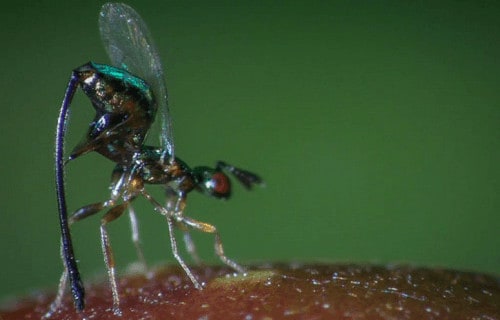
CCL: https://bit.ly/1p2b8Ke
Fig Wasp Facts
- Placing fifth in the sequence of our 7 Wondrous Wasps Worldwide is the Fig Wasp. It has an extraordinary story to tell.
- Firstly, the term Fig Wasp common name refers to any member species of a specific polyphyletic group of wasps. Furthermore, these display a rather remarkable form of complete coevolution with the fig tree.
- Most notably, the survival of each species in this group remains completely dependent upon the fig tree. This occurs because the female simply will not lay eggs in any other place.
- As part of the coevolution, the member species of this group represent the only insects that fertilize the fig tree. Therefore, the two species have become entirely dependent upon each other.
Fig Wasp Physical Description
Firstly, the fascinating Fig Wasp displays an unusual form of sexual dimorphism. But, in itself, this fact remains unsurprising. However, in this particular species, it appears in an uncommon fashion.
First of all, the females have the physical appearance common to wasps. In most species, however, the males remain completely wingless. Aside from the lack of wings, the males possess the same physical characteristics as the female.
Also, the exact coloring understandably varies somewhat between the different types. But, yellow and black predominate among them. This trait seems to also be prevalent among many related creatures.
- Kingdom: Animalia
- Phylum: Arthropoda
- Class: Insecta
- Order: Hymenoptera
- Superfamily: Chalcidoidea
Fig Wasp Distribution, Habitat, and Ecology
The many varieties of Fig Wasp, estimated to be in excess of 900, inhabit a wide variety of regions. Yet the tropics contain the greatest percentage of the invertebrates. Most types of this insect prefer warmer climates.
However, although the majority evolved as tropical species, a total of two inhabit regions of North America. Further, within that broad range, these two thrive in virtually all warmer sections.
The female burrows into the syconium of a fig tree to lay her eggs. And in doing so, she deposits pollen from other fig trees, thus pollinating the tree. After laying the eggs, the female dies. Once the larvae hatch, the males begin burrowing out of the fig. These then mate with the female, exit the fig, and die soon after.
Bald-Faced Hornet

CCL: https://bit.ly/1ryPA8o
Bald-Faced Hornet Facts
- Further adding to to variety amid our selections of 7 Wondrous Wasps Worldwide is the often maligned Bald-Faced Hornet.
- Despite its common name, the fierce-looking invertebrate does not actually rank as a true hornet. This surprising fact only proves once again that names can be deceiving.
- This amazing eusocial insect actually constitutes a specific species of the yellow jacket. Furthermore, it remains well known for its construction of large conical nests, built from paper-like materials.
- The colonies of this rather impressive invertebrate also sometimes contain as many as 700 workers. This counts as the largest number of workers of any species within its genus.
- The insect builds its nests typically in trees, or under the roofs of buildings. Further, the insect will aggressively defend the nest, repeatedly stinging possible predators.
- Finally, its distinctive name understandably derives from the fascinating markings on its face. These, along with its overall coloring, distinguishes it from others in its genus.
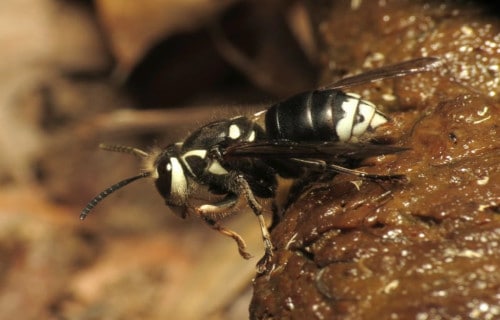
CCL: https://bit.ly/1ryPA8o
Bald-Faced Hornet Physical Description
First of all, the first description of the visually remarkable Bald-Faced Hornet occurred in 1763. First, the majority of related species appear black and yellow. Yet, this variety typically appears black and white in color. The majority of its white coloring also appears on the face.
Further, this species also typically attains a larger size than other yellowjacket varieties. However, it nonetheless remains somewhat small. Due to this trait, the adult attains an average length of about 0.75 in (19 mm).
Furthermore, workers remain covered in numerous small hairs. Meanwhile, however, the body of the queen remains hairless. In addition, the queen typically attains a much larger size than the rest of the colony.
- Kingdom: Animalia
- Phylum: Arthropoda
- Class: Insecta
- Order: Hymenoptera
- Family: Vespidae
- Genus: Dolichovespula
- Species: D. maculata
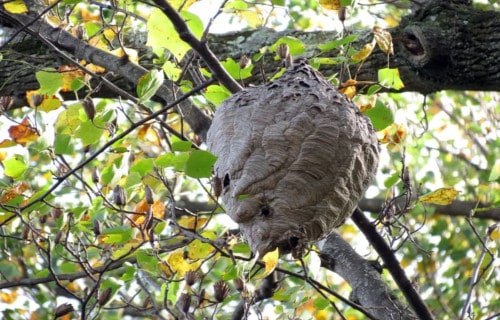
CCL: https://bit.ly/1ryPA8o
Bald-Faced Hornet Distribution, Habitat, and Ecology
The aggressive yet lovely Bald-Faced Hornet inhabits areas throughout North America, including southern Canada. Yet it seems most prevalent in the southeastern sections of the United States.
Despite its aggressive nature, this species prefers to build its nests in forested regions. Yet it will when necessary, establish colonies near urban areas, even sometimes on the sides of inhabited structures.
This fascinating creature also has an omnivorous diet. While humans often fear it, the Bald-Faced Hornet actually serves a beneficial purpose. It consumes large numbers of flies, caterpillars, and spiders.
The insect also possesses a unique defense mechanism, in addition to its painful sting. It also has the ability to squirt venom from its stinger into the eyes of small predators invading the nest.
Giant Ichneumon Wasp
Giant Ichneumon Wasp Facts
- The final entry into this compendium of 7 Wondrous Wasps Worldwide is one many would not expect to find on such a list, the Giant Ichneumon Wasp.
- The attention-grabbing term for this species quite perfectly serves as the most accepted common name for a distinctive insect. It does possess an alternate common name, though. That’s the comical, but accurate, term of the stump stabber.
- As difficult as the most often used term may seem, it’s somewhat easier to pronounce than the scientific name of the species. That’s due to the fact that its official name remains that of the Megarhyssa macrurus. Neither choice is easy to use.
- By either of these tongue-twisting names, though, it remains a most impressive variety of invertebrate. As a member of the Megarhyssa genus, it shares a remarkable trait. It, along with its related creatures, has an incredibly long ovipositor.
- For the moment, unlike many other species, the Giant Ichneumon Wasp appears to be maintaining a stable population base. The IUCN therefore does not currently have a listing for it. Any such listing would appear on the organization’s Red List.
- Yet, it could be considered to be facing at least some risks. Although it has a respectable range, much of its habitat remains at risk. As a result, the arthropod could face danger in the future, primarily in the form of habitat loss and climate change.
Giant Ichneumon Wasp Physical Description
The fascinating Giant Ichneumon Wasp has a most distinctive physical appearance. It also displays the physiological trait of sexual dimorphism. In its particular case, however, like many members of its genus, this principle manifests itself in two separate ways.
Firstly, the body of the male attains a slightly smaller size than that of the female. She reaches a body length of roughly 2 in (5 cm), with him lagging slightly behind. Secondly, the male has no ovipositor at all. In the female, this can reach 3 in (7.6 cm) in length.
Otherwise, both genders of the amazing Giant Ichneumon Wasp share basically identical appearances. The basic color pattern of the body presents as a reddish-brown shade. This has a relatively dense covering of yellow-orange and black stripes, however.
Both males and females further develop powerful wings, and rank as skilled fliers. Again mimicking its related species, the wings remain transparent in nature. Finally, the body of the awesome arthropod itself possesses a thin, highly elongated shape.
- Kingdom: Animalia
- Phylum: Arthropoda
- Class: Insecta
- Order: Hymenoptera
- Family: Ichneumonidae
- Genus: Megarhyssa
- Species: M. macrurus
Giant Ichneumon Wasp Distribution, Habitat, and Ecology
Among its many kindred species, the truly remarkable Giant Ichneumon Wasp inhabits a comparatively wide section of the world. That’s due to the fact that this wonder of nature and evolution appears in moderately large portions of the continent of North America.
More precisely, the great majority of its native range consists of the eastern half of the United States. However, this zone of habitation does reach into one other country. The northern most part of its range enters the extreme south of Canada, close to the Great Lakes.
Within that relatively extensive range, the insect appears to be reasonably adaptable to varying habitats. Generally, individuals thrive in any reasonably wooded region of that territory. That frequently even includes areas such as public parks and even yards.
Although it appears at most altitudes in the region of the world it inhabits, it does shy away from certain areas. More precisely, it typically avoids regions of hot, arid deserts. It also avoids areas without a sufficiently extensive concentration of trees, such as the plains.
That’s due to the basic nature and needs of the Giant Ichneumon Wasp. Although it remains totally harmless to humans, the larvae of the species feeds as parasites. These consume the larvae of another variety of insect, while the adults do not feed at all.
7 Wondrous Wasps Worldwide

CCL: https://bit.ly/1ryPA8o
We hope that you enjoyed this article about 7 Wondrous Wasps Worldwide. Nature has blessed this world with innumerable forms of life. While perhaps not all will be considered as beautiful or wonderful by everyone, such adjectives remain unimportant. All that really matters is that all forms of life are worthy of respect and consideration. Let us do all that we can to protect and preserve these 7 Wondrous Wasps Worldwide, and all species in the world, for future generations.
Check out our other articles on 4 Genuinely Gorgeous Grasshoppers, Native North American Mammals, Earth’s Geothermal Marvels, 7 Stunning European Flowering Plants
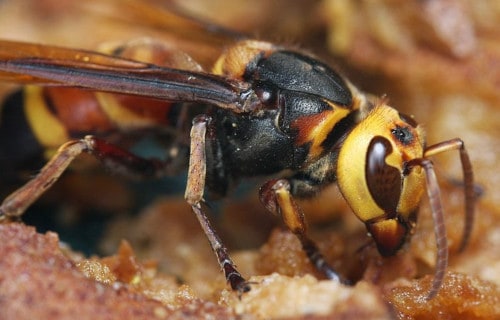
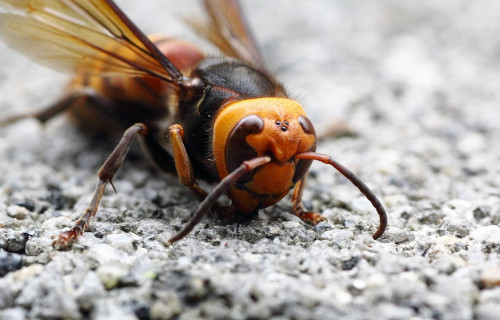
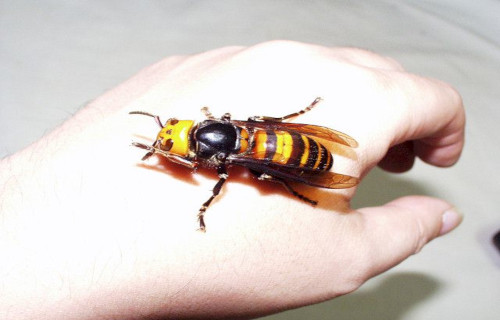
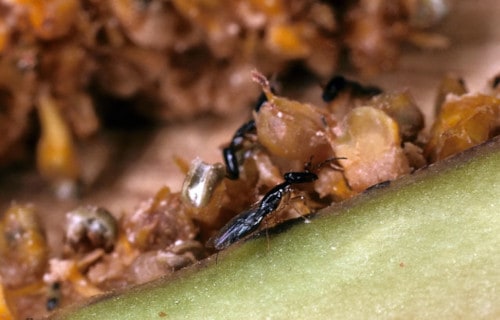
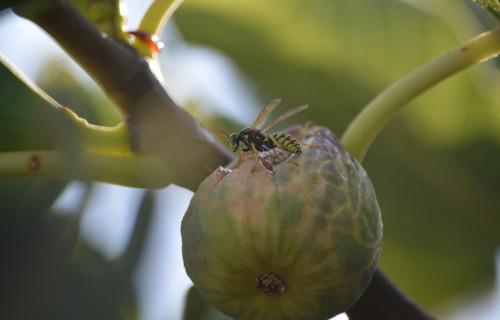
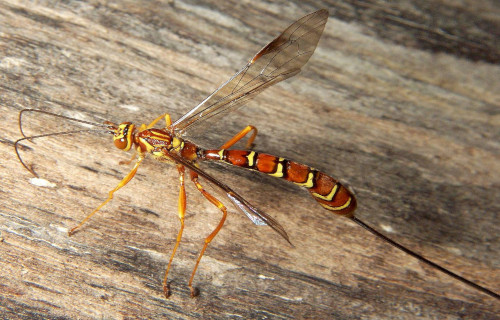
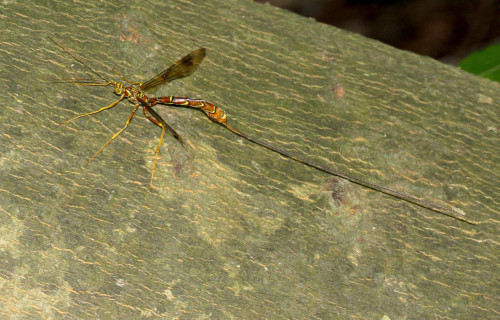










Leave a Reply